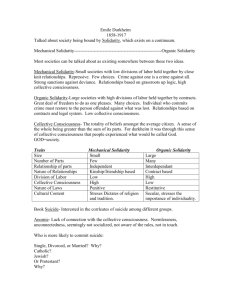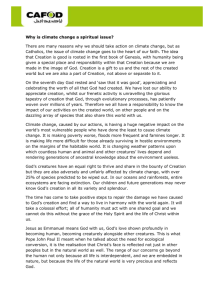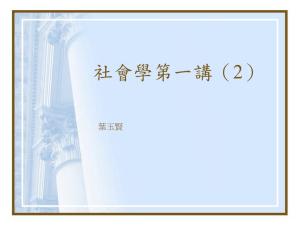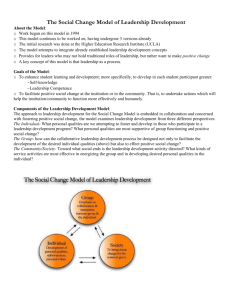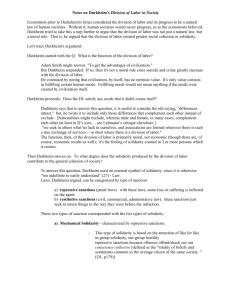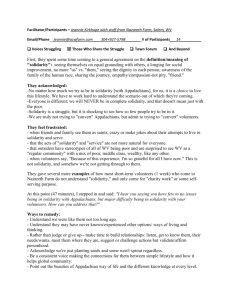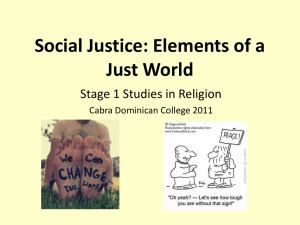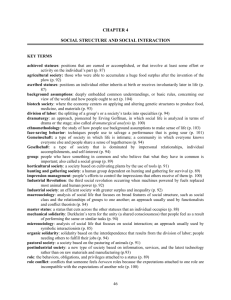Chapter 4
advertisement
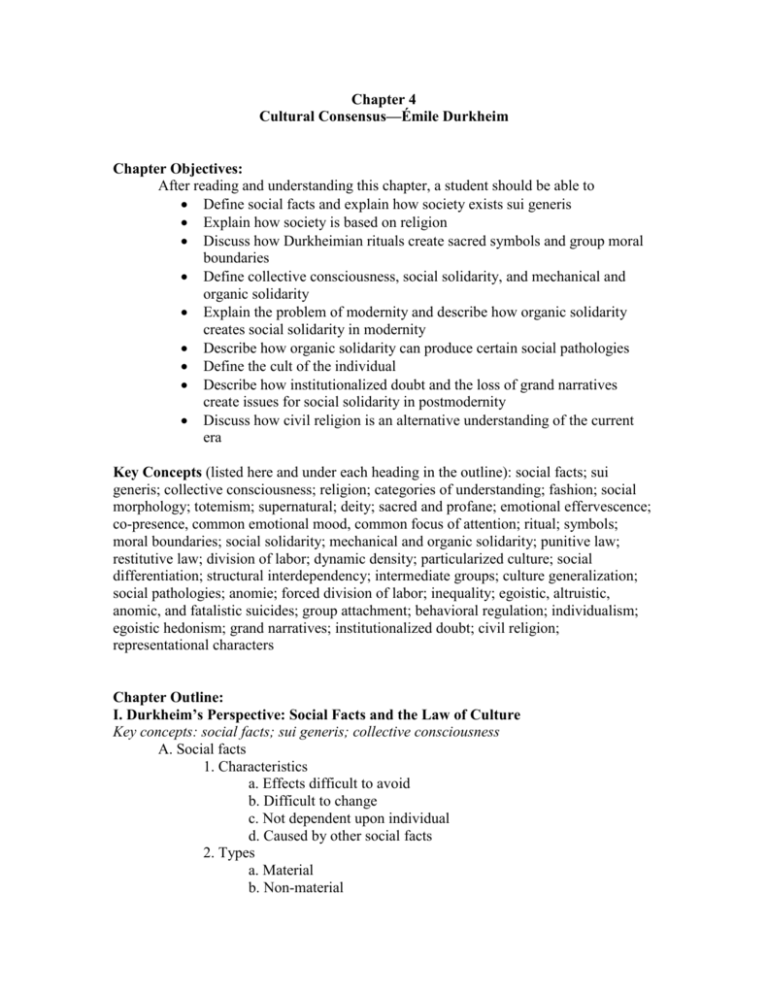
Chapter 4 Cultural Consensus—Émile Durkheim Chapter Objectives: After reading and understanding this chapter, a student should be able to Define social facts and explain how society exists sui generis Explain how society is based on religion Discuss how Durkheimian rituals create sacred symbols and group moral boundaries Define collective consciousness, social solidarity, and mechanical and organic solidarity Explain the problem of modernity and describe how organic solidarity creates social solidarity in modernity Describe how organic solidarity can produce certain social pathologies Define the cult of the individual Describe how institutionalized doubt and the loss of grand narratives create issues for social solidarity in postmodernity Discuss how civil religion is an alternative understanding of the current era Key Concepts (listed here and under each heading in the outline): social facts; sui generis; collective consciousness; religion; categories of understanding; fashion; social morphology; totemism; supernatural; deity; sacred and profane; emotional effervescence; co-presence, common emotional mood, common focus of attention; ritual; symbols; moral boundaries; social solidarity; mechanical and organic solidarity; punitive law; restitutive law; division of labor; dynamic density; particularized culture; social differentiation; structural interdependency; intermediate groups; culture generalization; social pathologies; anomie; forced division of labor; inequality; egoistic, altruistic, anomic, and fatalistic suicides; group attachment; behavioral regulation; individualism; egoistic hedonism; grand narratives; institutionalized doubt; civil religion; representational characters Chapter Outline: I. Durkheim’s Perspective: Social Facts and the Law of Culture Key concepts: social facts; sui generis; collective consciousness A. Social facts 1. Characteristics a. Effects difficult to avoid b. Difficult to change c. Not dependent upon individual d. Caused by other social facts 2. Types a. Material b. Non-material 3. Example: suicide B. Collective consciousness 1. Definition: collective representations and sentiments that guide and bind together any social group 2. Variability: performance of collective rituals C. Social interaction and Durkheim’s Law 1. Intrinsic link between interactions and culture production 2. Basis for problems of modernity II. Religious Roots of Society Key concepts: religion; categories of understanding; fashion; social morphology; totemism; supernatural; deity; sacred and profane; emotional effervescence; copresence, common emotional mood, common focus of attention; ritual; symbols; moral boundaries A. Religion and science 1. Basis of society a. Religious sense of transcendence (based on collective effervescence) b. Social morphology and religion i. Basic categories of understanding ii. Cosmology B. Defining religion 1. Based on most basic form (foundation of all religion) 2. Not included: ideas of supernatural or deity a. Supernatural first requires idea of nature b. Not all religions are centered on worship of deity (such as Buddhism) C. Creating the sacred 1. Fundamental issue: almost any object or symbol can be considered sacred; thus, sacredness not a feature of correspondence to any true state of the universe 2. Study of aborigines a. Two general cycles of group life b. During large gatherings mundane rules of social life set aside 3. Large gatherings an occasion for ritual performance a. Co-presence b. Mutual focus of attention c. Common emotional mood 4. Effects of ritual (Figure 4.1) a. Collective effervescence/emotional energy (sense of transcendence) b. Collective, sacred symbols c. Group moral boundaries III. Social Diversity and Morality Key concepts: social solidarity; mechanical and organic solidarity; punitive law; restitutive law; division of labor; dynamic density; particularized culture; social differentiation; structural interdependency; intermediate groups; culture generalization; social pathologies; anomie; forced division of labor; inequality A. Mechanical and organic solidarity 1. Social solidarity definition: the degree to which social units are integrated 2. Three features a. Individual subjective sense of group membership b. Constraint of individual desires c. Coordination of individuals and social units 3. Principally varies by level of collective consciousness a. Four features/variables of collective consciousness i. Degree to which culture is shared ii. The amount of power the culture has to guide individual’s thoughts, feelings, and actions iii. The degree of clarity iiii. Secular v. religious content 4. Two types (Table 4.1) a. Mechanical: solidarity through high levels of group cohesiveness and normative regulation—punitive or repressive law b. Organic: solidarity through mutual dependency, generalized culture, and intermediate groups and organizations—restitutive law B. The division of labor and the problem of modernity (Figure 4.2) 1. Modernity characterized by high division of labor a. Interaction in separated groups = particularized cultures and social differentiation (Durkheim’s law) 2. Result: problems of social integration C. Solution: organic solidarity 1. Organic solidarity a. Structural interdependency b. Generalized (abstract) culture c. Intermediate groups 2. Problems with organic solidarity 1. Social pathologies (associated with organismic analogy) a. Anomie b. Class inequality and forced division of labor i. Solution: Social justice measures enforced by the state —Price controls by useful labor (equal work, equal pay) —Elimination of inheritance IV. Individualism Key concepts: egoistic, altruistic, anomic, and fatalistic suicides; group attachment; behavioral regulation; individualism; egoistic hedonism A. Suicide (possible social pathology associated with organic solidarity) 1. Rate of suicide is a social fact caused by other social facts 2. Social variables a. Group attachment b. Behavioral regulation 3. Types of suicide (Table 4.2) a. Egoistic: low group attachment b. Altruistic: high group attachment c. Anomic: low behavioral regulation d. Fatalistic suicides: high behavioral regulation B. Cult of the individual 1. Not egoistic hedonism 2. Idea of individual as locus of rights and responsibilities a. Sacred symbol of modernity V. Thinking About Modernity and Postmodernity Key concepts: grand narratives; institutionalized doubt; civil religion; representational characters A. Modernity based on organic solidarity, which implies a generalized culture 1. Durkheim’s uncertainty – period of transition noted by moral mediocrity B. Two features of postmodernity 1. Grand narratives a. Based on Western colonialism and idea of political freedom and equality b. Grand narratives now held suspect 2. Institutionalized doubt a. Science C. Alternative to postmodernism: civil religion 1. Functions of religion moved to state 2. Civil religion based on a. Public discourse around social justice issues b. Civil themes and representational characters Chapter Summary: Durkheim is extremely interested in what holds society together in modern times. In order to understand this problem, he constructs a perspective that focuses on three issues: social facts, collective consciousness, and the production of culture in interaction. Durkheim argues that society is a social fact, an entity that exists in and of itself, which can have independent effects. The facticity of society is produced through the collective consciousness, which contains collective ideas and sentiments. The collective consciousness is seen as the moral basis of society. Though it may have independent effects, the collective consciousness is produced through social interaction. Durkheim argues that the basis of society and the collective consciousness is religion. Religion first emerged in society as small bands of hunter/gatherer groups assembled periodically. During these gatherings, high levels of emotional energy were created through intense interactions. This emotional energy, or effervescence, acted as a contagion and influenced the participants to behave in ways they normally wouldn’t. So strong was the effervescent effect that participants felt as if they were in the presence of something larger than themselves individually, and the collective consciousness was born. The emotional energy was symbolized and the interactions ritualized so that the experience could be duplicated. The symbols and behaviors became sacred to the group and provided strong moral boundaries and group identity. Because of high levels in the division of labor, modern society tends to work against the effects of the collective consciousness. People in work related groups and differentiated structures create particularized cultures. As a result, society has to find a different kind of solidarity than one based on religious or traditionally based collective consciousness. Organic solidarity integrates a structurally and socially diverse society through interdependency, generalized ideas and sentiments, restitutive law and centralized power, and through intermediary groups. These factors take time to develop and if a society tries to move too quickly from mechanical to organic solidarity, it will be subject to pathological states, such as anomie and the forced division of labor. At the center of modern society is the cult of the individual. The ideal of individuality, not the idiosyncrasies of individual people, becomes one of the most generalized values a society can have. However, the individual can also be subject to pathological states, depending on their level of group attachment and behavioral regulation. If a society produces the extremes of either of these, then the suicide rate will tend to go up. Suicide due to extremes in group attachment is characterized as either egoistic or altruistic. Suicide due to extremes in behavioral regulation is characterized as either anomic or fatalistic. Durkheim’s argument for social solidarity is a moral one. He holds the hope out that one day a religious like grand narrative will once again provide the firm center for society. Some thinkers, like Robert Bellah, agree with Durkheim and argue that civil religion can provide just such a base. However, postmodernists are unsure that such a grand narrative is possible or even desirable. Postmodernists point to the pervasive doubt that has come about through the decentering of religion, the failure of Western colonialism, the effects of mass media and markets, and the doubt intrinsic within science itself as reasons why a Durkheimian grand narrative is unlikely. Further, grand narratives themselves are based on privileged knowledge: in order to produce a grand narrative a particular kind of knowledge has to be seen as more important than all others. Grand narratives are thus morally objectionable, under postmodern values.
